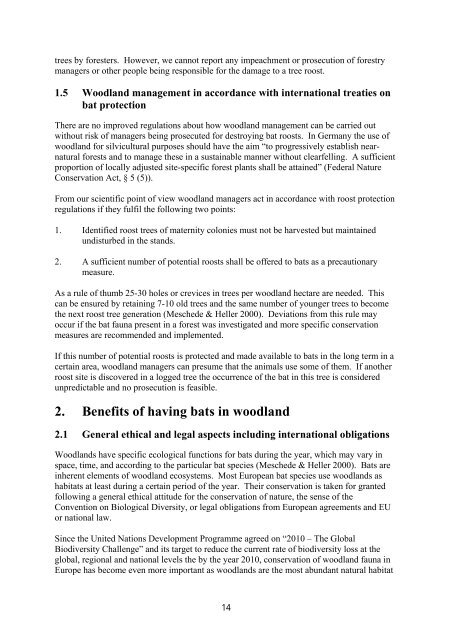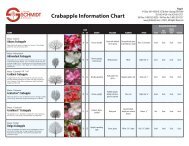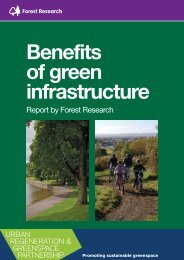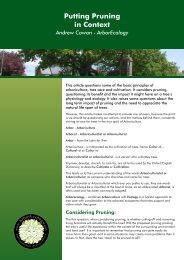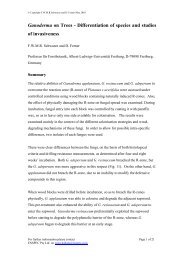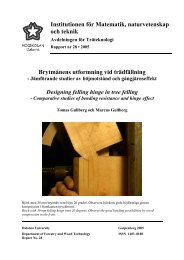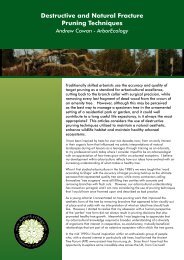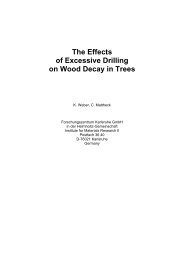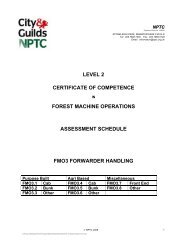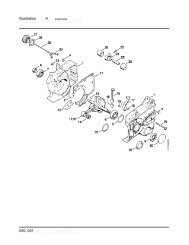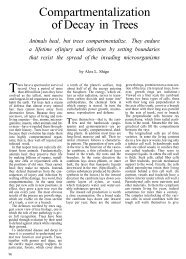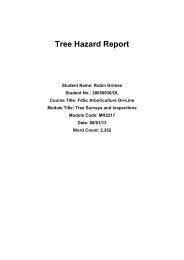working today for nature tomorrow - Justus-Liebig-Universität GieÃen
working today for nature tomorrow - Justus-Liebig-Universität GieÃen
working today for nature tomorrow - Justus-Liebig-Universität GieÃen
- No tags were found...
Create successful ePaper yourself
Turn your PDF publications into a flip-book with our unique Google optimized e-Paper software.
trees by <strong>for</strong>esters. However, we cannot report any impeachment or prosecution of <strong>for</strong>estrymanagers or other people being responsible <strong>for</strong> the damage to a tree roost.1.5 Woodland management in accordance with international treaties onbat protectionThere are no improved regulations about how woodland management can be carried outwithout risk of managers being prosecuted <strong>for</strong> destroying bat roosts. In Germany the use ofwoodland <strong>for</strong> silvicultural purposes should have the aim “to progressively establish nearnatural<strong>for</strong>ests and to manage these in a sustainable manner without clearfelling. A sufficientproportion of locally adjusted site-specific <strong>for</strong>est plants shall be attained” (Federal NatureConservation Act, § 5 (5)).From our scientific point of view woodland managers act in accordance with roost protectionregulations if they fulfil the following two points:1. Identified roost trees of maternity colonies must not be harvested but maintainedundisturbed in the stands.2. A sufficient number of potential roosts shall be offered to bats as a precautionarymeasure.As a rule of thumb 25-30 holes or crevices in trees per woodland hectare are needed. Thiscan be ensured by retaining 7-10 old trees and the same number of younger trees to becomethe next roost tree generation (Meschede & Heller 2000). Deviations from this rule mayoccur if the bat fauna present in a <strong>for</strong>est was investigated and more specific conservationmeasures are recommended and implemented.If this number of potential roosts is protected and made available to bats in the long term in acertain area, woodland managers can presume that the animals use some of them. If anotherroost site is discovered in a logged tree the occurrence of the bat in this tree is consideredunpredictable and no prosecution is feasible.2. Benefits of having bats in woodland2.1 General ethical and legal aspects including international obligationsWoodlands have specific ecological functions <strong>for</strong> bats during the year, which may vary inspace, time, and according to the particular bat species (Meschede & Heller 2000). Bats areinherent elements of woodland ecosystems. Most European bat species use woodlands ashabitats at least during a certain period of the year. Their conservation is taken <strong>for</strong> grantedfollowing a general ethical attitude <strong>for</strong> the conservation of <strong>nature</strong>, the sense of theConvention on Biological Diversity, or legal obligations from European agreements and EUor national law.Since the United Nations Development Programme agreed on “2010 – The GlobalBiodiversity Challenge” and its target to reduce the current rate of biodiversity loss at theglobal, regional and national levels the by the year 2010, conservation of woodland fauna inEurope has become even more important as woodlands are the most abundant natural habitat14


